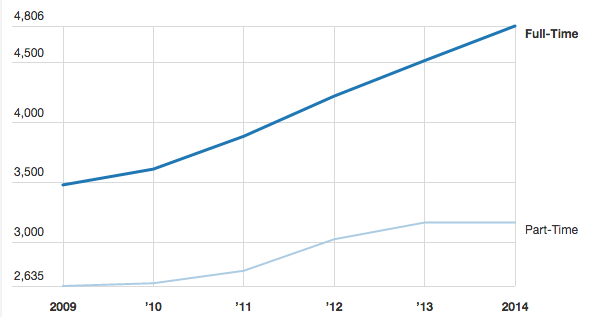Nine to Five, After 65
The number of senior citizens in the workforce has nearly tripled since the 1970s.
If you can afford it, the ability to enjoy one's elderly years out of the office is ideal. But longer lifespans often mean that retiring at a more traditional age requires workers to save up larger nest eggs and spend dozens of years living on dwindling savings.
Retiring at 65 has long been considered arbitrary , and while the U.S. abolished mandatory retirement in 1986 , some countries have only started phasing out compulsory retirement in the last decade. In the U.S., employment of those aged 65 and older doubled between 1977 and 2007 and continues to climb.
Employment for Workers 65 and Over (in thousands)

Not only is overall employment for this group trending up, older workers are also increasingly working full-time instead of part-time. In 1995, seniors working full-time overtook their part-time peers. And both sets of workers have seen their numbers rise in the past five years. The Bureau of Labor Statistics projects that the participation rate of workers 65 and older will rise to 23 percent in 2022.
Workers 65 and Over, by Work Schedule (in thousands)

The aging population is perhaps already starting to show its impact in the labor market. Consider that the average age of the U.S. labor force has increased by about five years in the last decade: The median age of the U.S. worker is now 42.4 . Meanwhile, youth employment has been trending down for years—which has been attributed to both an increased focus on education rather than work, and the recent recession, which decreased job opportunities for teens as competition for jobs typically held by teens increased.
Wolfgang Fengler and Johannes Koettl, lead economist and senior economist at the World Bank, respectively, looked at this trend of elderly workers in European countries . They write that part of this phenomenon is the incredible demographic shift that's happening globally: By 2050, it's expected that the share of senior citizens will triple to 15 percent of the world's population (1.5 billion). Another piece of the puzzle is the changing nature of work; in today's economy, the age of one's physical peak is often divorced from the best years of productivity. They point to the fact that some jobs require cognitive skills that are considered "age-appreciating"—in other words, skills that actually improve with age. According to one research paper , these skills can be anything from technical writing to human-resources management.
Continuing to work past the age of 65 might sound terrible, but some studies have shown that working (or volunteering) can be a good thing for the health of seniors. As Fengler and Koettl write, the idea of retiring at 65 was bizarre to begin with: "A binary system of working 100 percent until retirement and then suddenly moving to zero percent at an arbitrary age of around 65 is one of the great anachronisms of today’s labor market in many OECD countries."
( Top image via Photographee.eu / Shutterstock.com )



